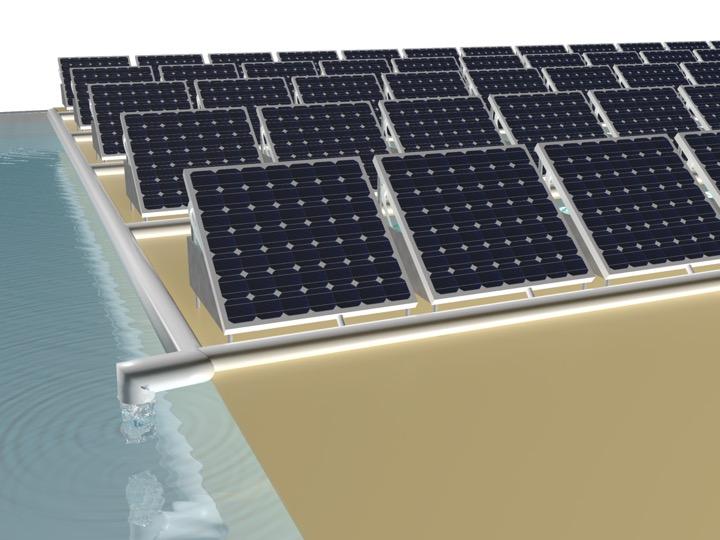Solar power with a free side of drinking water

A solar farm of photovoltaic panels with a heat-driven seawater desalination system beneath each panel could co-generate renewable electricity and fresh water in arid coastal areas. Credit: © 2019 Wenbin Wang
Water and energy production is deeply intertwined, says Wenbin Wang, a Ph.D. student in Peng Wang's labs at the University's Water Desalination and Reuse Center. Conventional solar farms use fresh water to wash dust from the panels.
Meanwhile, water desalination plants consume a lot of electricity to produce fresh water from seawater. “The water-energy nexus is one of the main issues threatening sustainable global development,” Wenbin says.
Professor Wang and his team have developed a device that could ease this problem. Commercial PV panels turn sunlight into electricity with a maximum efficiency of 20 percent.
The remaining 80 percent is wasted, mainly just shed into the surrounding air as heat. The team has designed an integrated device that could capture this heat and use it to generate fresh water.
The researchers built a device in which a stack of water channels, separated by porous hydrophobic membranes and heat conduction layers, were attached to the underside of a commercial PV panel.
Waste heat from the panel vaporized seawater in the uppermost channel; the vapor crossed the porous membrane and condensed as fresh water in a clean water channel just below.
As the vapor condensed, its heat passed through a thermal conduction layer to the next seawater channel, recycling the energy to purify more water.
Using three stacked layers of water distillation channels, and passing the energy from layer to layer, the device produced up to 1.64 litres of water per square meter of solar panel surface every hour.
That is more than double the water output of traditional solar stills, which use a one-stage design, Wenbin says. Meanwhile, the PV panel's electricity output was unaffected by the water desalination taking place beneath it.
Media Contact
All latest news from the category: Power and Electrical Engineering
This topic covers issues related to energy generation, conversion, transportation and consumption and how the industry is addressing the challenge of energy efficiency in general.
innovations-report provides in-depth and informative reports and articles on subjects ranging from wind energy, fuel cell technology, solar energy, geothermal energy, petroleum, gas, nuclear engineering, alternative energy and energy efficiency to fusion, hydrogen and superconductor technologies.
Newest articles

A universal framework for spatial biology
SpatialData is a freely accessible tool to unify and integrate data from different omics technologies accounting for spatial information, which can provide holistic insights into health and disease. Biological processes…

How complex biological processes arise
A $20 million grant from the U.S. National Science Foundation (NSF) will support the establishment and operation of the National Synthesis Center for Emergence in the Molecular and Cellular Sciences (NCEMS) at…

Airborne single-photon lidar system achieves high-resolution 3D imaging
Compact, low-power system opens doors for photon-efficient drone and satellite-based environmental monitoring and mapping. Researchers have developed a compact and lightweight single-photon airborne lidar system that can acquire high-resolution 3D…





















